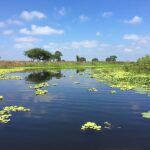Financing the restoration economy: Why Kenya’s strategy could become a blueprint for Africa

Photo credit: UNCCD/G20 Global Land Initiative
When we, representing UNCCD/G20 Global Land Initiative (G20 GLI), visited Kenya earlier this year, one theme argument came up in every conversation, be it with youth entrepreneurs in Nairobi or farmers in Kajiado: restoration needs more than good will; it needs capital, markets and partnerships.
That reality is at the heart of Kenya’s National Landscape and Ecosystem Restoration Strategy (2023–2032). This plan is not just about planting trees but about financing the restoration economy. It is anchored in the government’s Bottom-Up Economic Transformation Agenda (BETA), which aims for an economic turnaround and inclusive growth
The Strategy aims to restore 10.6 million hectares of degraded land and raise tree cover to 30 per cent by 2032. What makes it unique is how it is designed to get there: by treating the private sector, MSMEs (micro, small and medium enterprises) and youth as central and equal players to other classic restoration actors, namely, government and non-governmental organizations.
Under Strategic Objective 4, a full financing architecture for restoration is established to address:
- Capacity assessments to identify where funding gaps exist.
- Training and proposal development to help actors — especially MSMEs — to access finance.
- Provide support to craft bankable projects and business plans.
- A Public–Private Partnerships (PPP) framework for ecosystem restoration.
- Strengthened national restoration funds with clear governance.
This is the kind of enabling environment where innovation and inclusion thrive.
By assigning 14.4 per cent of national tree-growing and 22.2 per cent of seedling production to non-state actors, Kenya makes a deliberate space for businesses to act.
Through the Kenya Private Sector Alliance (KEPSA) and the Kenya Association of Manufacturers (KAM), companies are encouraged to reduce pollution, align sustainability with restoration and co-invest in landscape recovery.
In short, the private sector shifts from donor to co-investor, channeling finance where it matters most — on the ground.
At the same time, the journey from strategy to execution remains a critical gap to bridge. The mechanisms are written, the partnerships envisioned and the financing logic is sound.
But they need activation.
This is where collaboration can turn commitments into momentum, by taking up the offer already outlined in the Strategy and bringing it to life through joint programmes, investment platforms and youth-led delivery models.
And this is exactly where the G20 GLI work comes alive. By engaging at the national level, we are stitching the pieces together. We are bringing universities, accelerators, business associations (KEPSA/KAM) and county actors to the same table.
The Strategy explicitly references youth empowerment and embeds MSMEs in its financing agenda. G20 GLI’s role then is to help the country to turn that intent into bankable opportunities for Kenya’s young ecopreneurs, such as the ones we met, who are running seedling nurseries, converting waste into biofertilizer and building digital tools for soil and water monitoring.
As the G20 GLI continues its engagement in Kenya, we aim to help unlock this space to turn policy into practice and ensure the restoration economy envisioned on paper takes root in the landscapes, communities and enterprises driving it.




